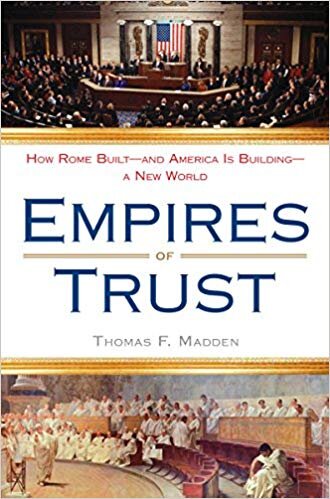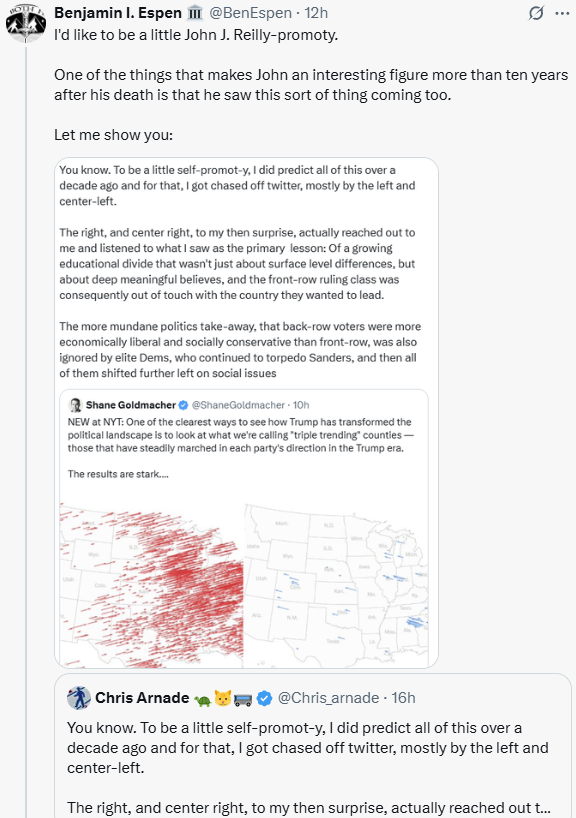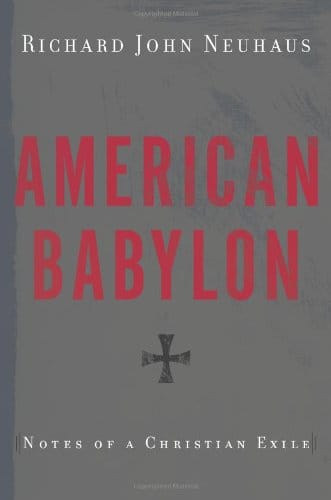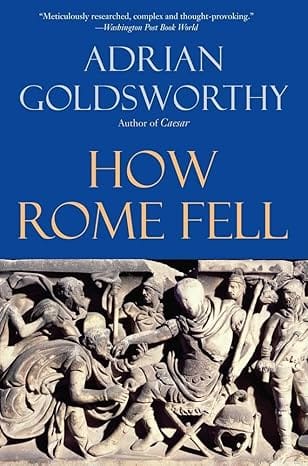The Long View: Empires of Trust: How Rome Built -- and America Is Building -- a New World By Thomas F. Madden
I love this quote:
[Madden] is well aware that aspects of their societies that seem similar are often quite different in spirit and function. The dustjacket sports an photograph of the US Senate and a dramatic rendering of Cicero addressing the Roman Senate; both bodies were called a “senate,” but there were essential differences in the recruitment, authority, and procedure between that ancient assembly of reckless freelance windbags and America's own timid and mumbly legislatures.
I also appreciate this discussion of the senses of the word Empire. I do think you can usefully add in the colonialist sense of a center or metropole that extracts resources from a periphery, but you just can’t let it crowd out the other senses.
The author's basic argument is that the term "empire" may properly be used of two different kinds of polities: empires of conquest, meaning states that expand by destroying or absorbing other states of the same class; and empires of trust, which are essentially confederal structures, of at least legally equivalent allies, whose central participant can be trusted to render aid to the other members without attempting to absorb them. (In a nod to Niall Ferguson, the author allows that there may be a third class of empire, the "empire of commerce," whose chief exemplars are Periclean Athens, Renaissance Venice, and Victorian Britain). An empire of conquest can blaze across half the world in a generation and then collapse just as quickly. Its components did not ask to belong to it, and therefore will often take advantage of the first opportunity to secede. An empire of trust is not essentially a state; its unifying institutions may be quite informal. Nonetheless, once such an empire coalesces, it is remarkably durable. Just as important, it tends to grow.

Empires of Trust:
How Rome Built -- and America Is Building -- a New World
By Thomas F. Madden
336 Pages, US$25.95
Dutton, 2008
ISBN-10: 0525950745
Thomas Madden is a revisionist's revisionist. A medievalist, he has heretofore been best known for A New Concise History of the Crusades [Amazon link], which seeks to sort out the actual history of the Crusades from the anti-colonialist gloss that has deformed our view of those events since the mid-20th century. Now, in Empires of Trust [Amazon link], he has undertaken a perhaps even more ambitious reformation of the public mind: to correct sloppy uses of the analogy of ancient Rome to the situation of America in today's world. Specifically, he seeks to refute a recent flurry of polemical books that equate the position of America with that of Rome at the cusp of the fall (and usually equate George Bush with one of the battier emperors). The author does not take the historical nominalist position that no such analogy is possible, or that the past has nothing to teach us. Rather, he makes point that, if we are going to compare history of the United State to date with that of Rome, the best analogy is to the Roman Republic. The Republic lasted from the overthrow of the last Etruscan-Roman king around 510 B.C. to the return of monarchy with the advent of the Principate in 27 B.C. More precisely, he suggests that Rome's position in 202 B.C. at the end of the Second Punic was analogous to that of the United States globally in A.D. 1945. The development of Rome and its world after that point may also have something to tell us.
Only a fool would just lay out the history of Rome and the modern West side-by-side and expect them to match point-for-point, much less to predict the future in detail beyond the present date. Certainly the author undertakes no such folly. He is well aware that aspects of their societies that seem similar are often quite different in spirit and function. The dustjacket sports an photograph of the US Senate and a dramatic rendering of Cicero addressing the Roman Senate; both bodies were called a “senate,” but there were essential differences in the recruitment, authority, and procedure between that ancient assembly of reckless freelance windbags and America's own timid and mumbly legislatures. However, even if the details are different, the author does make a plausible case that the historical dynamic of politics in Rome was indeed parallel to that of the United States, at least through the 20th century.
The author's basic argument is that the term "empire" may properly be used of two different kinds of polities: empires of conquest, meaning states that expand by destroying or absorbing other states of the same class; and empires of trust, which are essentially confederal structures, of at least legally equivalent allies, whose central participant can be trusted to render aid to the other members without attempting to absorb them. (In a nod to Niall Ferguson, the author allows that there may be a third class of empire, the "empire of commerce," whose chief exemplars are Periclean Athens, Renaissance Venice, and Victorian Britain). An empire of conquest can blaze across half the world in a generation and then collapse just as quickly. Its components did not ask to belong to it, and therefore will often take advantage of the first opportunity to secede. An empire of trust is not essentially a state; its unifying institutions may be quite informal. Nonetheless, once such an empire coalesces, it is remarkably durable. Just as important, it tends to grow.
The process is simple enough. The algorithm is that a state generally deals with defeated enemies by turning them into allies rather than annexing or destroying them. These allies have enemies of their own, who in turn must be defeated and converted. Meanwhile, of course, distant states who were never enemies at all see the advantage of joining the alliance system. This process is, actually, not a bad description of the expansion of the Roman “empire,” understood as the alliance system of the Republic, at least through the Punic Wars and in large measure through the first half of the second century BC. The Romans sought to “secure the horizon,” a horizon that continued to recede until it reached, and slightly exceeded, the limits of the Mediterranean civilizations.
The irony is that the core motive for the process was isolationism. Early republican Rome was wedged between the turbulent Hellenized world of southern Italy and the perpetual military threat posed from the north, first by the Etruscans (who took the Romans’ secession from their hegemony in bad part) and then by the whooping barbarity of the plundering Celts. Rome did not like to be interfered with by foreigners, and was quite willing not to interfere with them, but the closest it could come to these goals was an essentially reactive defense strategy. Rome organized the neighboring cities to defeat attackers and then, preferably, turn the attackers into allies. According to the author, expansion of the empire was first “pushed” by the desire to make Rome itself secure, and then “pulled” by the feedback process that tended to add ally to ally.
Readers may remark that "an empire of trust" in this sense is not so different from Daniel Deudney's definition of a "republic," and that the mechanism by which it forms is an example of the "non-zero-sum interaction" described by Robert Wright. However, the author claims that the process is not purely mechanical, but predicated in some measure on the characteristics of the societies involved. He draws a provocative, if not necessarily persuasive, parallel between the “civil religions” of Rome and America. Neither society was ever a theocracy in the strong sense of the term, but both made use of a public piety that is just a scaled-up version of the private, house-hold religion that informed these societies’ early histories. Thus, it would never have occurred to George Washington not to take the first presidential oath on a Bible, though that was nowhere prescribed, and the Roman municipal cult of the god Janus was a generalized version of the household traditions associated with every home’s doorway.
The author is, perhaps, on firmer ground when he suggests that Roman, and American, presumptions about how to deal with the outside world were strongly conditioned by their own political cultures. Rome was a free republic, with a large measure of internal civil liberty. Romans protested throughout their history that they wanted nothing better than to be left alone. Similarly, they thought, other states should be free republics, too, and should leave each other alone. This formulation may seem to some readers a bit too Kantian for the end of the first millennium B.C. However, it does correctly suggest that the Roman policy of peace through a pacifying alliance would work well only with a state that was fundamentally like Rome: a state like a Greek polis, with a tradition of legal sovereignty and responsible self-government. The Romans never tried to treat the more primitive societies of Iberia and Gaul and Britain as equal allies. Before long, they found that not every polis could join their system of legal equals. When the Romans arrived in Sicily during the First Punic War (264 B.C.-241 B.C.) (again, the Romans were defending their allies, this time against Carthage and Syracuse), they defeated the overlords of Hellenistic cities whose political culture was that of tributary states. These cities could not defend themselves. They were eager to pay taxes to any hegemon that could be trusted to keep the peace. That was how the Roman institution of the “province” began. By the second half of the second century B.C., the alliance status of the cities of Greece also became increasingly nominal. The author says the problem was that the Greeks understood “freedom,” which the Romans always claimed to be guaranteeing, naturally included the freedom of one Greek city to attack another. The Romans began keeping permanent garrisons in the area.
Empires of Trust is not strictly a narrative history of Rome or America, but the author does give a sense of historical thermodynamics, of the way that political systems age over time. The author notes that the traditional civility of Roman domestics politics began to decay at just the time, around the middle of the second century B.C., when Rome and its empire of trust became really secure, even from the post-Alexandrine successor states of the East. One of the most interesting features of the book is the author’s review of the “doomsday literature” that began to appear at about this time in Greek and, later, in Latin. Rome’s enemies and admirers both noted the decline in the honesty and reasonableness of the Romans, and made dire surmises about the future of the city. (The direst surmise of all, of course, is to be found in The Book of Revelation, written over a century after the end of the Republic, but continuing a tradition that was already well established in the time of Polybius (203 – 120 B.C.). Closer to home, Roman patriots noted the increasing nastiness of public life, the decay of ancient institutions, and the enervating spread of vice and luxury.
Though the author does not make this suggestion, a study should be done of the dwindling prominence in modern Western literature of the traditional Roman reputation for depravity. Within living memory, students who read widely in classical literature would find behavior that would, literally, never otherwise have occurred to them. The fact that the Romans’ scandal-mongering soap-opera history is now at least matched by the contents of actual soap operas may be connected to the diminished popularity of classics as an academic major. But this is a digression.
The terminal crisis of the Republic began when Caesar started a civil war in 49 B.C., a crisis lasted a generation. One of the features of the politics of the Republic in its last century or so was the internalization of the disputes of its allies. Famously, in the case of Numidia and its usurper king Jugurtha (circa 110 B.C.), the feuding dynasty and its hired agents were busy bribing and lobbying politicians in Roman even while Roman armies were dithering in the field. Less flagrant incidents of foreign disputes becoming Roman domestic issues were common. Rome early on was given the opportunity to rule Egypt as a province. Rome chose instead to continue the Ptolemaic dynasty, whose deranged internal squabbles famously played an important role in the Republic’s last civil wars.
The author makes the interesting point that not just Rome’s allies, but also its enemies, made sophisticated of the increasingly rancorous Roman political system. Rome ran on annual elections, an institution that did not encourage long-term thinking in public discourse. Adversaries like the Macedonians and Numidians understood perfectly well that drawn-out wars of attrition created a domestic political opposition eager to capitalize on the discomfiture of whichever party started the war. As the author points out, this kind of opportunism was not even just a feature of the late Republic: conservatives in Senate tried to stab Scipio in the back when he was bringing the Second Punic War to a successful close in Africa.
The lesson we are to take from all this unpleasantness, according to the author, is that domestic politics does not count for much. Despite all the hew and cry, Roman strategic interests had a logic of their own that the pillow fight of Roman politics did remarkably little to deflect. This was true even of the liminal case: the Republic actually ended and the Roman state became a different form of regime, but still the empire of trust endured. Indeed, it endured for 500 years (1500, if you count the Byzantine Empire, which the author does but shouldn’t). The author does not use the term “emergent behavior,” but that seems to have been what the empire displayed. It was an institution with unplanned properties that served purposes other than those for which it had been created.
This brings us back to Roman doomsday literature. When people like Polybius and Cicero and Sallust forecast the ruin of Rome, the author notes, they were in fact onto something. Cicero and Sallust actually lived to see the fall of the Republic. The author suggests that the end of the Republic was not inevitable (his favorite authority on the subject seems to be the inappropriately sanguine Eric Gruen). Rather, he points to a specific flaw in the Roman constitution. The Romans did not attempt to separate civilian from military leadership. A Roman general was a Roman civilian politician with a commission to conduct specific operations in a designated territory for a limited period of time. That seemed to the Romans control enough. The problem was that, sometimes, those windbags in the Senate turned out to be military geniuses. One might almost say that Caesar started his civil war because he found himself momentarily at a loss for words.
Perhaps we should draw comfort from the fact that a relatively minor constitutional reform, the subordination of the military to civilian authority, would have preserved the Republic. Indeed, the Founding Fathers of the United States, well aware of the Roman precedent, introduced just that reform into their own constitution. Thus, the author argues, the United States is structurally incapable of following the Roman path. That argument is persuasive, if it is meant to prove that exactly what happened to Rome will not happen to the United States. It would offer perfect comfort only if we assume that the American constitution is innocent of all other flaws.
The author uses ancient analogies to suggest the outcome of current and possible future issues, such the outcome of the war in Iraq, or the dissemination of American citizenship on a global scale. One such analogy that we may not neglect is a long comparison between the centuries’ long Roman effort to incorporate Judaism into its empire and the current difficulties of the West with Islamism.
In his discussion of the empire as a byproduct of aid to allies, the author frequently cites the First Book of Maccabees (Catholic canon; Protestant apocrypha), which describes the new Jewish polity seeking and obtaining an alliance with Rome against the Seleucid Empire, from which it was attempting to break away. In later years, the Romans would conquer the remnants of that empire and make the new Jewish state secure. Judea ought to have become just another ally. That was not what happened. Even though the Romans generally made no fuss about accommodating Jewish practices in the rest of the empire, there was a violent apocalyptic streak in first century Judaism that prevented the incorporation of the region into the Roman system. Indeed, it prevented the internal government of the Jewish territories, which was why the Romans could not simply ignore them. The relationship flipped back and forth between alliance with Jewish kings and direct Roman military government. Nothing worked. The situation decayed into terrorist assassinations and partisan warfare, and finally the slaughter of Roman forces at Jerusalem and elsewhere. The Romans destroyed Jerusalem in A.D. 70. About 60 years later, they depopulated the country.
Nonetheless, the Romans did not attempt to destroy Judaism or the Jews. Rather, they saw to it that the religion changed from a national ideology to a personal faith. At any rate, this is the author’s view of the matter. To this one might suggest that the tendency toward Rabbinical Judaism began well before the destruction of the Temple, and it is probably a misconstruction of “Judaism” to identify it with the enthusiasms of the mutually homicidal fanatics who took over Jerusalem before its fall. Be this as it may, the author leaves us to draw our own lessons from this sorry tale for the future of the West’s interaction with Islam.
Empires of Trust is intended for a popular readership, so it is understandable if it neglects the huge literature that seeks to compare the modern era to Hellenistic times. Still, readers familiar with that literature may regret the lack of even an occasional glance. For instance, anyone familiar with Oswald Spengler’s model of history could not help but notice that the comparison of first-century Judaism to 21st century Islam is a comparison of the earliest Spring to the latest Winter of what Spengler called the Magian Culture of the Middle East. Perhaps more on point, it would be a fruitful study to compare Empires of Trust with Amaury de Riencourt’s The Coming Caesars, published about fifty years ago. Both books are on essentially the same subject; the earlier book focuses more on the transition between Republic and formal Empire. Riencourt himself was trying to update Spengler’s Decline of the West, published a generation earlier. The different preoccupations of these three works show that different times are different lenses on the same past.
We can only wonder: what image might some fourth lens reveal in 2058?
Copyright © 2008 by John J. Reilly
Support the Long View re-posting project by downloading Brave browser. With Both Hands is a verified Brave publisher, you can leave me a tip too!



Comments ()